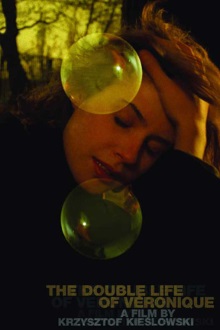
Considering how much we liked the Three Colors trilogy as a whole, it was inevitable that we would watch this earlier film by Krzysztof Kieślowski. This is especially true since it also stars Irène Jacob who is probably our favorite of the three leading ladies from the trilogy. Less obviously, like Bleu, it also showcases music by composer Zbigniew Preisner as a major element of the plot, in this case ascribing it to a fictional Dutch composer named Van den Budenmayer.
As you might predict from looking at its title, Jacob plays two distinct characters in The Double Life of Véronique. One is the Polish Weronika who happens to be a talented singer. The other is the French Véronique who is a music teacher. In addition to being physically identical, they seem to share a mysterious spiritual link, yet they never really meet. The other major character is a man who initiates a strange experiment with Véronique. Both a puppeteer and a writer of children’s books, he appears to have some knowledge of the link between the two young women, yet seems unconscious of it.
Seen in the cold light of day, it’s a story that doesn’t make any sense, full of unexplained events, tenuous links and sly suggestions of the supernatural. How did the puppeteer Fabbri know to send the symbolic shoelace to Véronique? What is the nature of the strange light that she sees? How does the music of the late Van den Budenmayer connect the two? What is the significance of old women struggling with burdens? Yet the genius of Kieślowski is that he makes it all work. The film inexorably draws you into its world, a world that is not governed by logic or reason but by intuition, art and spiritual connections. In here, the characters and events take on a poetic and metaphysical meaning that defies conventional storytelling.
A couple of key elements make this possible. The first is the beautiful cinematography with the vivid colors that would later so characterize the Three Colors trilogy. The second is of course Jacob’s performance which encompasses at once both great strength and a terrible fragility. Reading this article on the actress for example, I’m struck by the fact that while Jacob would continue to appear in many more films, no director after Kieślowski was able to capture this unique quality about her. I also think that the mesmerizing puppet performance in here is worth a shout-out. Performed by professional puppeteer Bruce Schwartz, the puppet dances look incredibly human and life-like, yet combined with the deadness of their painted faces, it creates the ultimate Uncanny Valley effect.
The more cynical side of me thinks that audiences see so much meaning in this film precisely because it is so amorphous and what the characters say so general. It’s a masterful technique surely and there’s no doubt that it works but simultaneously I also can’t help but feel somewhat cheated because the director is getting away with doing less work. For this reason, as powerful and raw as this film is, I still prefer the Three Colors trilogy with its more clearly defined themes.